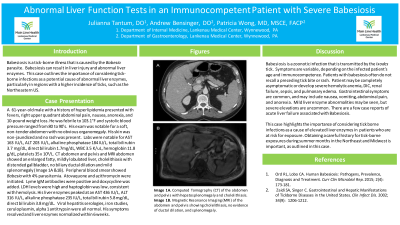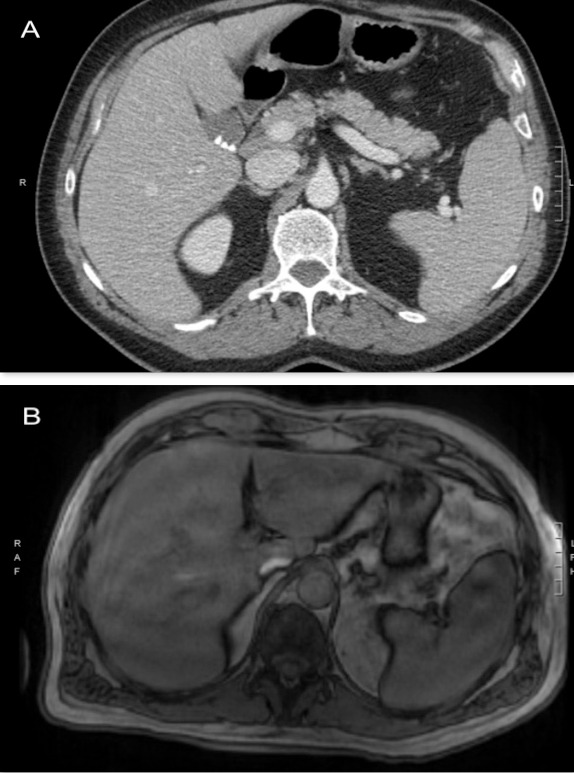Back


Poster Session A - Sunday Afternoon
Category: Liver
A0536 - Abnormal Liver Function Tests in an Immunocompetent Patient With Severe Babesiosis
Sunday, October 23, 2022
5:00 PM – 7:00 PM ET
Location: Crown Ballroom

Has Audio

Julianna Tantum, DO
Lankenau Medical Center
Wynnewood, PA
Presenting Author(s)
Julianna Tantum, DO1, Andrew Bensinger, DO1, Patricia Wong, MD2
1Lankenau Medical Center, Wynnewood, PA; 2Lankenau Medical Center, Philadelphia, PA
Introduction: Babesiosis is a tick-borne disease that is caused by the Babesia parasite. Babesia is a rare cause of liver function test (LFT) abnormalities. This case outlines the importance of keeping tick-borne and parasitic infections on the differential for abnormal LFTs, especially in patients who live in the Northeastern United States.
Case Description/Methods: A 61-year-old male presented to the emergency department for fevers, abdominal pain, nausea, decreased oral intake, and 10-pound weight loss. On arrival, he was febrile to 103.1°F and blood pressures 80-90s. His exam was notable for a soft, non-tender abdomen without hepatosplenomegaly or ascites and skin without rashes or jaundice. Labs showed AST 163 IU/L, ALT 203 U/L, alkaline phosphatase (AP) 184 IU/L, total bilirubin(TB) 3.7 mg/dL, direct bilirubin(DB) 1.7mg/dL, WBC 3.5 K/uL, hemoglobin 11.8 g/dL, platelets 35 x 109/L. CT abdomen and pelvis with IV contrast and MRI abdomen with gadolinium showed an enlarged fatty, mildly lobulated liver, cholelithiasis, distended gallbladder, no biliary ductal dilation and mild splenomegaly (Image 1A &1B). A peripheral blood smear was obtained since he lived near woods and fed foxes, showing Babesia with 4% parasitemia. He was started on atovaquone and azithromycin. Lyme Disease was positive; Doxycycline was added. An undetectable haptoglobin and LDH of 679 were consistent with hemolysis. LFTs peaked at AST 436 IU/L, ALT 316 IU/L, AP 235 IU/L, TB 5.8 mg/dL, DB 3.8 mg/dL on hospital day 5. Viral hepatitis serologies, ANA, ASMA, and ceruloplasmin were unrevealing. His symptoms and labs improved. Five days after discharge no parasites were seen on blood smear. LFTs normalized six weeks later.
Discussion: Babesiosis is a zoonotic infection that is transmitted by Ixodes ticks. Symptoms depend on patient age and immunocompetence, ranging from asymptomatic infection to severe disease including hemolytic anemia, DIC, renal failure, sepsis, and pulmonary edema. Gastrointestinal symptoms of nausea, vomiting, abdominal pain, and anorexia are common. Mild LFT abnormalities may occur but severe elevations are uncommon. Acute liver failure has been reported. This case highlights the importance of a broad differential when evaluating patients with elevated LFTs. While fevers and malaise may suggest underlying infection, patients with babesiosis often do not recall a tick bite or develop a rash. Obtaining a careful history for tick borne exposures during summer months in the Northeast is important, as outlined in this case.

Disclosures:
Julianna Tantum, DO1, Andrew Bensinger, DO1, Patricia Wong, MD2. A0536 - Abnormal Liver Function Tests in an Immunocompetent Patient With Severe Babesiosis, ACG 2022 Annual Scientific Meeting Abstracts. Charlotte, NC: American College of Gastroenterology.
1Lankenau Medical Center, Wynnewood, PA; 2Lankenau Medical Center, Philadelphia, PA
Introduction: Babesiosis is a tick-borne disease that is caused by the Babesia parasite. Babesia is a rare cause of liver function test (LFT) abnormalities. This case outlines the importance of keeping tick-borne and parasitic infections on the differential for abnormal LFTs, especially in patients who live in the Northeastern United States.
Case Description/Methods: A 61-year-old male presented to the emergency department for fevers, abdominal pain, nausea, decreased oral intake, and 10-pound weight loss. On arrival, he was febrile to 103.1°F and blood pressures 80-90s. His exam was notable for a soft, non-tender abdomen without hepatosplenomegaly or ascites and skin without rashes or jaundice. Labs showed AST 163 IU/L, ALT 203 U/L, alkaline phosphatase (AP) 184 IU/L, total bilirubin(TB) 3.7 mg/dL, direct bilirubin(DB) 1.7mg/dL, WBC 3.5 K/uL, hemoglobin 11.8 g/dL, platelets 35 x 109/L. CT abdomen and pelvis with IV contrast and MRI abdomen with gadolinium showed an enlarged fatty, mildly lobulated liver, cholelithiasis, distended gallbladder, no biliary ductal dilation and mild splenomegaly (Image 1A &1B). A peripheral blood smear was obtained since he lived near woods and fed foxes, showing Babesia with 4% parasitemia. He was started on atovaquone and azithromycin. Lyme Disease was positive; Doxycycline was added. An undetectable haptoglobin and LDH of 679 were consistent with hemolysis. LFTs peaked at AST 436 IU/L, ALT 316 IU/L, AP 235 IU/L, TB 5.8 mg/dL, DB 3.8 mg/dL on hospital day 5. Viral hepatitis serologies, ANA, ASMA, and ceruloplasmin were unrevealing. His symptoms and labs improved. Five days after discharge no parasites were seen on blood smear. LFTs normalized six weeks later.
Discussion: Babesiosis is a zoonotic infection that is transmitted by Ixodes ticks. Symptoms depend on patient age and immunocompetence, ranging from asymptomatic infection to severe disease including hemolytic anemia, DIC, renal failure, sepsis, and pulmonary edema. Gastrointestinal symptoms of nausea, vomiting, abdominal pain, and anorexia are common. Mild LFT abnormalities may occur but severe elevations are uncommon. Acute liver failure has been reported. This case highlights the importance of a broad differential when evaluating patients with elevated LFTs. While fevers and malaise may suggest underlying infection, patients with babesiosis often do not recall a tick bite or develop a rash. Obtaining a careful history for tick borne exposures during summer months in the Northeast is important, as outlined in this case.

Figure: Image 1A. Computed Tomography (CT) of the abdomen and pelvis with IV contrast showed evidence of hepatosplenomegaly and cholelithiasis. 1B. Magnetic Resonance Imaging (MRI) of the abdomen and pelvis with gadolinium showed cholelithiasis, no evidence of ductal dilation, and splenomegaly.
Disclosures:
Julianna Tantum indicated no relevant financial relationships.
Andrew Bensinger indicated no relevant financial relationships.
Patricia Wong indicated no relevant financial relationships.
Julianna Tantum, DO1, Andrew Bensinger, DO1, Patricia Wong, MD2. A0536 - Abnormal Liver Function Tests in an Immunocompetent Patient With Severe Babesiosis, ACG 2022 Annual Scientific Meeting Abstracts. Charlotte, NC: American College of Gastroenterology.

